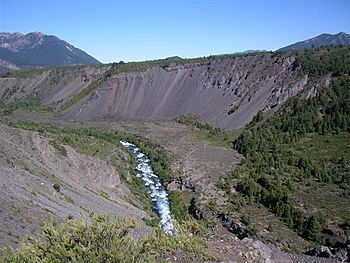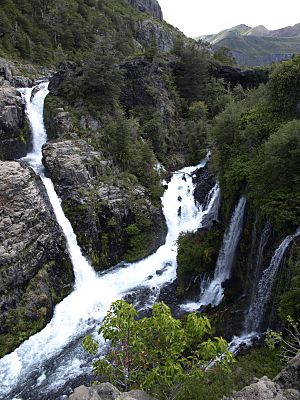Laja River (Chile) facts for kids
Quick facts for kids Laja River |
|
|---|---|
 |
|
| Country | Chile |
| Physical characteristics | |
| Main source | Laguna del Laja |
| River mouth | Biobío River |
| Length | 140 km (87 mi) |
| Basin features | |
| Basin size | 4,040 km2 (1,560 sq mi) |
The Laja River (called Río De La Laja in Spanish) is an important river in Chile. It flows through the Bío Bío Region and is famous for the beautiful Laja Falls. The river starts high up in the Andes mountains, from a large lake called Laguna del Laja. From there, it flows west through the flat Chilean Central Valley. Finally, it joins the Biobío River, becoming a key part of that larger river system.
Contents
Exciting Whitewater Adventures
The Laja River is very popular with people who love whitewater kayaking. Kayakers know it for its exciting Class 5 rapids, which means the water flows very fast and steeply. This makes for a thrilling ride!
What's special about the Laja River is how it begins. The water actually comes out from the bottom of Lake Laja, through the side of a mountain. Because of this unique start, the river's water level stays almost the same all year round. This makes it a reliable spot for whitewater sports.
Powering Homes with Water
The Laja River is also important for making electricity. This is called hydropower. There are three large power plants located near the outlet of Lake Laja. These plants use the force of the flowing water to create energy.
- The El Toro Hydroelectric Plant was built in 1973 and can produce 400 megawatts of power.
- The Antuco Hydroelectric Plant was built in 1981 and can produce 300 megawatts of power.
These plants help provide electricity to many homes and businesses in Chile.
Watering Farmlands
Before the Laja River reaches the famous Laja Falls, its water is used to help grow crops. About 70,000 hectares (which is like 700 square kilometers) of farmland are watered by the river. This is called irrigation, and it helps farmers grow food in the area.
A Look at the River's Past
In 1984, some companies had a plan to change the path of the Laja River. They wanted to send its water to a different river further north. Their goal was to build new hydropower plants there.
However, many people were against this plan. They worried that moving the water would cause the beautiful Laja Falls to dry up. They also feared it would make pollution worse in the lower Biobío River. This is because the Laja River's water helps to dilute, or spread out, the pollution from the upper Biobío River. Without the Laja's water, the pollution would become more concentrated. Farmers also worried that their right to use the river's water for irrigation would be taken away.
Even though a court did not stop the plan, it became very unpopular. Because of all the public concern and debate, the idea of changing the river's path was eventually given up.
See also
 In Spanish: Río Laja (Biobío) para niños
In Spanish: Río Laja (Biobío) para niños


